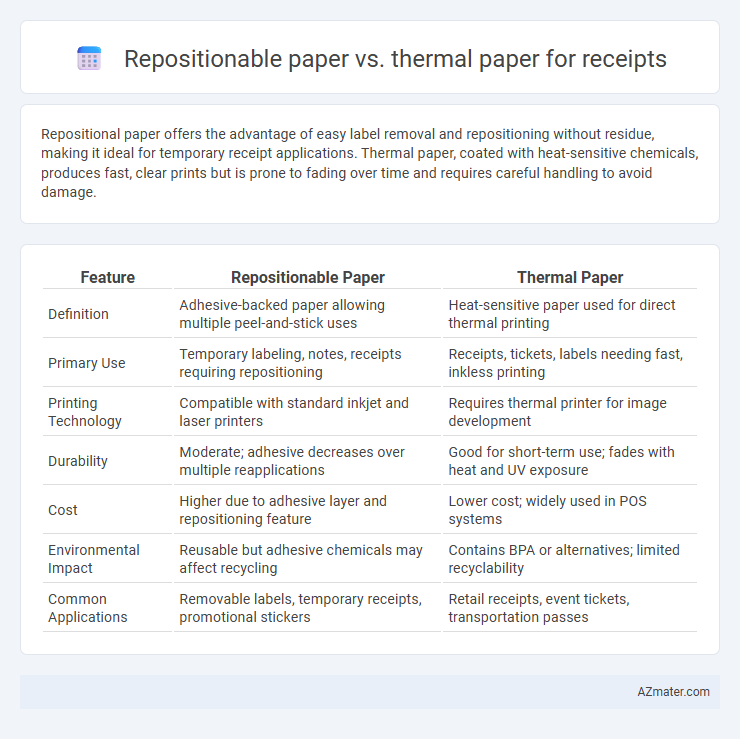Repositional paper offers the advantage of easy label removal and repositioning without residue, making it ideal for temporary receipt applications. Thermal paper, coated with heat-sensitive chemicals, produces fast, clear prints but is prone to fading over time and requires careful handling to avoid damage.
Table of Comparison
| Feature | Repositionable Paper | Thermal Paper |
|---|---|---|
| Definition | Adhesive-backed paper allowing multiple peel-and-stick uses | Heat-sensitive paper used for direct thermal printing |
| Primary Use | Temporary labeling, notes, receipts requiring repositioning | Receipts, tickets, labels needing fast, inkless printing |
| Printing Technology | Compatible with standard inkjet and laser printers | Requires thermal printer for image development |
| Durability | Moderate; adhesive decreases over multiple reapplications | Good for short-term use; fades with heat and UV exposure |
| Cost | Higher due to adhesive layer and repositioning feature | Lower cost; widely used in POS systems |
| Environmental Impact | Reusable but adhesive chemicals may affect recycling | Contains BPA or alternatives; limited recyclability |
| Common Applications | Removable labels, temporary receipts, promotional stickers | Retail receipts, event tickets, transportation passes |
Introduction to Receipt Paper Types
Receipt paper types primarily include repostional paper and thermal paper, each serving distinct printing needs. Thermal paper features a heat-sensitive coating that produces images through thermal printers without the need for ink, ensuring fast and clear receipt printing. Repositional paper allows receipts to be peeled and repositioned without damage, ideal for temporary labeling or proof-of-purchase scenarios requiring easy attachment and removal.
What is Repositional Paper?
Repositional paper is a type of receipt paper designed to allow temporary adhesion, enabling users to lift and reposition the receipt without damaging the paper or losing clarity. Unlike thermal paper, which relies on heat-sensitive coatings to produce images, repositional paper typically uses low-tack adhesives that maintain print quality while allowing multiple placements. This feature makes repositional paper ideal for applications requiring frequent handling, such as receipts that customers need to move or attach temporarily.
What is Thermal Paper?
Thermal paper is a special fine paper coated with chemicals that change color when exposed to heat, commonly used in receipt printers for instant, high-quality printing without ink. In contrast, repositionable paper allows printed receipts to be moved or repositioned without damage, catering to different retail or office needs where temporary adhesion is beneficial. Thermal paper offers durability and crisp print resolution, making it ideal for fast, efficient transaction documentation in retail environments.
Printing Technology Differences
Repositionable paper employs a removable adhesive backing that allows the paper to be lifted and re-stuck multiple times without damaging the print, usually compatible with inkjet and laser printers requiring toner or ink. Thermal paper utilizes a heat-sensitive coating that reacts with the thermal print head to produce images without ink or toner, enabling faster and quieter printing primarily in direct thermal printers. The fundamental difference lies in thermal paper's reliance on heat to activate the coating for image creation, while repositionable paper depends on conventional printing technologies depositing ink or toner onto an adhesive layer.
Cost Comparison: Repositional vs Thermal
Repositional paper for receipts generally incurs higher costs due to its adhesive backing and specialized materials, making it more expensive per roll compared to thermal paper. Thermal paper is cost-effective, requiring no ink or toner and offering lower operational expenses, which leads to significant savings in high-volume printing environments. Businesses often choose thermal paper over repositional paper when prioritizing overall cost efficiency without sacrificing print quality.
Durability and Longevity of Receipts
Repositionable paper offers moderate durability with a coated adhesive allowing temporary attachment, but its receipts tend to fade faster and resist heat poorly compared to thermal paper. Thermal paper, composed of heat-sensitive layers, ensures longer-lasting receipts by maintaining print legibility for several years under proper storage conditions, with resistance to smudging and moisture. For businesses requiring durable records, thermal paper provides superior longevity, preserving transaction details more reliably than repositionable alternatives.
Environmental Impact and Sustainability
Repositionable paper, often coated with reusable adhesives, generates less waste by allowing multiple uses before disposal, thereby reducing environmental impact compared to traditional thermal paper. Thermal paper contains chemicals like BPA or BPS, which pose ecological and health risks during manufacturing and after disposal, contributing to pollution and landfill issues. Choosing repositionable paper supports sustainability efforts by minimizing chemical usage and promoting extended product life cycles, aligning with eco-friendly business practices.
User Experience and Functionality
Repositional paper offers enhanced user experience with its ability to be easily peeled off and reattached without losing adhesive strength, ideal for temporary receipts or labels. Thermal paper provides optimal functionality through fast, heat-based printing that ensures clear, smudge-resistant text, making it suitable for high-volume transaction environments. Both papers balance durability and convenience, but repositional paper is preferred for flexibility, while thermal paper excels in print quality and processing speed.
Industry Applications and Preferences
Repositional paper is favored in retail and hospitality industries for its flexibility in temporary labeling and easy removal without residue, making it ideal for price tags and promotions. Thermal paper is preferred in high-volume transaction environments such as supermarkets and banking due to its fast printing speed and durability, offering clear, long-lasting receipts essential for customer records. Industries prioritize thermal paper for permanent documentation and repositional paper where temporary information display and frequent updates are required.
Choosing the Right Receipt Paper for Your Business
Choosing the right receipt paper depends on your business needs and printing equipment compatibility; thermal paper offers faster printing and high-quality images ideal for retail and hospitality, while repositional paper provides the versatility of being repositioned without residue, useful for temporary labels or inventory tags. Thermal paper typically requires a thermal printer and is cost-effective for high-volume printing, whereas repositional paper suits businesses needing flexibility in label placement and frequent updates. Evaluating factors such as print durability, cost, and application type ensures optimal receipt paper selection to enhance customer experience and operational efficiency.

Infographic: Repositional paper vs Thermal paper for Receipt
 azmater.com
azmater.com